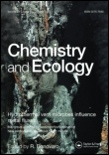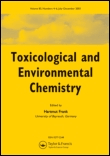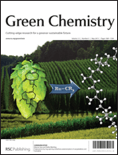
CHEMISTRY AND ECOLOGY
Scope & Guideline
Advancing the Frontier of Chemical-Ecological Insights
Introduction
Aims and Scopes
- Environmental Chemistry:
The journal explores the chemical composition of the environment, including pollutants, nutrients, and natural substances, and their interactions within various ecosystems. - Toxicology and Ecotoxicology:
Research on the effects of chemical substances, including heavy metals, pesticides, and pharmaceuticals, on living organisms and ecosystems is a core focus, highlighting the assessment of risks and impacts. - Bioremediation and Waste Management:
The journal emphasizes innovative methods for the remediation of contaminated environments using biological agents, including studies on biosorption and phytoremediation techniques. - Ecological Risk Assessment:
The assessment of ecological risks associated with chemical exposure, including the evaluation of pollutants' effects on biodiversity and ecosystem function, is a significant area of research. - Sustainable Practices and Green Chemistry:
The journal advocates for green chemistry approaches and sustainable practices in environmental management, focusing on reducing chemical hazards and promoting ecological balance.
Trending and Emerging
- Microplastics and Their Ecological Impact:
Recent studies increasingly address the prevalence of microplastics in various ecosystems, examining their effects on aquatic life and potential pathways for remediation. - Nanotechnology in Environmental Remediation:
Research on the application of nanomaterials for environmental cleanup and pollution control is gaining traction, showcasing innovative solutions to complex contamination issues. - Climate Change and Chemical Interactions:
There is a growing emphasis on understanding how climate change influences chemical processes in the environment, including effects on pollutant behavior and ecosystem responses. - Integrated Multi-Biomarker Approaches:
Emerging methodologies involving multiple biomarkers for assessing ecological health and the impacts of pollutants reflect a trend towards more comprehensive ecological assessments. - Phytoremediation and Bioengineering:
Studies focusing on the use of plants for pollutant removal and soil restoration are on the rise, indicating a shift towards sustainable and nature-based solutions in environmental management.
Declining or Waning
- Traditional Chemical Analysis Techniques:
There is a noticeable decline in papers focusing solely on traditional chemical analysis methods without integration into ecological contexts, as the field moves towards more interdisciplinary approaches. - Single-Species Toxicity Studies:
Research centered exclusively on the toxicity of chemicals to single species is becoming less common, with a shift towards understanding community-level impacts and ecosystem interactions. - Historical Pollution Studies:
While historical pollution assessments were once prevalent, there is a waning interest as the focus shifts to contemporary and emerging pollutants and their real-time impacts on ecosystems.
Similar Journals

TOXICOLOGICAL AND ENVIRONMENTAL CHEMISTRY
Unraveling the complexities of chemicals and their environmental effects.TOXICOLOGICAL AND ENVIRONMENTAL CHEMISTRY is a pivotal journal published by Taylor & Francis Ltd, addressing critical intersections between environmental chemistry and toxicology since its inception in 1979. With its ISSN 0277-2248 and E-ISSN 1029-0486, the journal serves as a platform for rigorous research and innovative methodologies in pollution control, health implications of environmental chemicals, and the broader spectrum of toxicological studies. Although it currently does not offer open access, the journal's impact in the field is underscored by its Category Quartiles rankings in 2023, placing it in Q3 across Environmental Chemistry, Health, Toxicology and Mutagenesis, and Pollution categories. Furthermore, its Scopus rankings reveal its significant role within the scientific community, specifically in areas such as Environmental Science and Toxicology. The journal aspires to foster multidisciplinary dialogue and advance knowledge that contributes to environmental sustainability and public health, making it an essential resource for researchers, professionals, and students dedicated to these fields.

GREEN CHEMISTRY
Exploring the synergy between chemistry and environmental stewardship.GREEN CHEMISTRY, published by the prestigious Royal Society of Chemistry, stands at the forefront of the rapidly evolving field of sustainable chemistry. Since its inception in 1999, this esteemed journal has consistently made significant contributions to environmental chemistry and pollution studies, achieving an impressive Q1 ranking in both categories as of 2023. With a distinguished presence in Scopus rankings, positioned at #10 in Environmental Science _ Pollution and #12 in Environmental Science _ Environmental Chemistry, GREEN CHEMISTRY is recognized for its commitment to advancing research that prioritizes eco-friendly practices and innovative methodologies. The journal serves as a vital platform for researchers and professionals dedicated to promoting sustainability and reducing environmental impact through chemistry, making it an essential resource for anyone interested in the intersection of chemistry and environmental sciences. Although it does not currently offer open access, its significant impact factor highlights its relevance and authority in the field. The journal is located at Thomas Graham House, Science Park, Milton Road, Cambridge, UK, and continues to engage a global audience of scientists and students passionate about green innovations.

Chemistry for Sustainable Development
Fostering Interdisciplinary Solutions for a Sustainable FutureChemistry for Sustainable Development is a leading journal dedicated to the exploration of innovative chemical studies that promote sustainability and environmental preservation. Published by the esteemed PUBLISHING HOUSE RUSSIAN ACAD SCIENCES, SIBERIAN BRANCH, this journal serves as a crucial platform for researchers, professionals, and students engaged in the field of chemistry, particularly those focused on sustainable practices and green technologies. With an ISSN of 0869-8538, the journal aims to bridge the gap between theoretical research and practical applications that align with sustainable development goals. By fostering interdisciplinary collaboration and sharing cutting-edge findings, Chemistry for Sustainable Development plays a vital role in addressing pressing global challenges such as climate change, resource depletion, and environmental degradation. Though currently not open access, the journal is committed to disseminating knowledge that inspires innovative solutions for a sustainable future.

ENVIRONMENTAL TOXICOLOGY AND CHEMISTRY
Pioneering research for a safer, cleaner environment.ENVIRONMENTAL TOXICOLOGY AND CHEMISTRY is a premier journal published by Wiley that has established itself as an essential resource for researchers, professionals, and students in the fields of environmental chemistry and toxicology. With a robust trajectory since its inception in 1982, the journal offers critical insights into the interactions between environmental pollutants and biological systems, aiming to advance our understanding of the impacts of toxins on health and ecosystems. Recognized in the top quartile (Q1) of both Environmental Chemistry and Health, Toxicology, and Mutagenesis categories as of 2023, the journal is respected for its rigorous peer-reviewed content and high impact factor. It ranks 33rd out of 148 in Health, Toxicology and Mutagenesis and 48th out of 147 in Environmental Chemistry according to Scopus metrics, placing it firmly within the most influential publications in these fields. Although it does not currently offer open access, the journal remains a vital conduit for disseminating cutting-edge research and innovative methodologies that address pressing environmental challenges.

ECOTOXICOLOGY AND ENVIRONMENTAL SAFETY
Elevating standards in ecotoxicology and public health research.ECOTOXICOLOGY AND ENVIRONMENTAL SAFETY, published by Academic Press Inc. Elsevier Science, stands as a premier journal in the field of environmental science, specializing in the intricate relationships between toxic substances and ecological systems. With a commendable impact factor and recognized as a Q1 journal in various categories including Health, Toxicology and Mutagenesis, and Public Health, it consistently ranks among the top publications in Scopus, placing it in the 96th percentile for Medicine and Public Health. Established in 1977, this journal addresses critical issues related to environmental safety and pollution, making it an essential resource for researchers, professionals, and students alike. Although it does not offer an open access option, the journal’s commitment to publishing rigorous and impactful research makes it a vital platform for advancing the understanding of ecotoxicological risk assessments and environmental protection strategies. For those dedicated to the intersection of science and public health, ECOTOXICOLOGY AND ENVIRONMENTAL SAFETY serves as a beacon of knowledge and innovative research.

Jordan Journal of Chemistry
Empowering Researchers: Unlocking the Potential of Chemistry in Jordan.The Jordan Journal of Chemistry is a prominent publication dedicated to advancing the field of chemistry in Jordan and beyond. Published by the Yarmouk University Deanship of Research & Graduate Studies, this journal serves as a platform for researchers, educators, and practitioners to disseminate their findings in a variety of chemistry sub-disciplines. Although currently classified in Q4 of miscellaneous chemistry and ranking within the 9th percentile according to Scopus, the journal plays a crucial role in fostering academic dialogue and collaboration in the region. With its ISSN 1814-9111 and E-ISSN 2079-7249, the Jordan Journal of Chemistry offers open access to researchers from diverse backgrounds, ensuring that critical research is both accessible and impactful. By bridging local studies with global scientific advancements, this journal is poised to contribute significantly to the growth and recognition of chemistry as a key scientific discipline in the region, with convergence efforts set from 2020 to 2024.

Ovidius University Annals of Chemistry
Diving Deep into the World of Chemical Innovation.Ovidius University Annals of Chemistry is a prominent open-access journal dedicated to the field of chemistry and chemical engineering, published by OVIDIUS UNIV PRESS since 2012. With its ISSN 1583-2430 and E-ISSN 2286-038X, this journal seeks to foster innovative research and disseminate knowledge across diverse chemical disciplines. Situated in the vibrant academic setting of Ovidius University in Constanta, Romania, this journal receives contributions from a global pool of researchers, enhancing its relevance in the international scientific community. The open-access format ensures that all published articles are freely available, promoting a wider reach and impact of the research dissemination. As a valued resource for academics, industry professionals, and students alike, the Ovidius University Annals of Chemistry plays a crucial role in advancing the understanding of chemical sciences and engineering practices.

Moroccan Journal of Chemistry
Bridging Local Insights with Global Chemistry Research.Moroccan Journal of Chemistry, published by the University Mohammed Premier Oujda, serves as a pivotal platform for researchers and professionals in the field of chemistry, particularly focusing on diverse and emerging areas within the discipline. Established in 2018, this open-access journal facilitates widespread dissemination of scholarly articles, ensuring that cutting-edge research reaches a global audience. With an ISSN of 2351-812X and categorized in the Q3 quartile for miscellaneous chemistry in 2023, the journal maintains rigorous peer-review standards while fostering an inclusive environment for scientific dialogue. Located in Morocco, it aims to bridge local and international research communities, contributing to the advancement of knowledge in chemistry. As it continues to grow, the Moroccan Journal of Chemistry remains an essential resource for students, educators, and professionals eager to stay abreast of the latest developments in the field.

Natural Products and Bioprospecting
Pioneering the Future of Natural Product ApplicationsNatural Products and Bioprospecting is a prestigious academic journal published by SPRINGERNATURE, dedicated to advancing research in the fields of analytical chemistry, biochemistry, plant science, organic chemistry, and pharmacology. With an impact factor that positions it within the top quartiles across multiple categories, this journal serves as a crucial platform for disseminating groundbreaking findings and innovative methodologies focusing on the potential of natural products. Since adopting its Open Access model in 2011, it has broadened its reach, allowing global accessibility to cutting-edge research. The journal, based in Singapore, aims to foster interdisciplinary collaboration and encourages submissions that explore the intricate relationships between natural products and their applications in food science, toxicology, and pharmacology. Its well-respected status is further highlighted by impressive Scopus ranks and a growing H-index, reinforcing its significance in the scientific community. Researchers, professionals, and students alike can benefit from the rich repository of knowledge that Natural Products and Bioprospecting continuously curates and disseminates, making it an invaluable resource in the quest for innovative solutions derived from nature.

Environmental Chemistry Letters
Fostering innovation in environmental chemistry.Environmental Chemistry Letters, published by Springer Heidelberg, stands at the forefront of interdisciplinary research within the field of Environmental Chemistry. Since its inception in 2003, this esteemed journal has provided a dynamic platform for the dissemination of innovative studies and groundbreaking findings, contributing significantly to the understanding of chemical processes affecting the environment. With an impressive impact factor and ranking third out of 147 journals in Environmental Chemistry (98th percentile as per Scopus), it consistently attracts high-quality submissions from researchers around the globe. The journal maintains a Q1 category rank as of 2023, underscoring its prominent position in scholarly discourse. Environmental Chemistry Letters is dedicated to advancing knowledge on contemporary environmental issues, fostering solutions to mitigate chemical pollution, and promoting sustainable practices across various sectors. Researchers, professionals, and students alike will find invaluable resources within its pages as it continues to illuminate the path toward environmental sustainability.